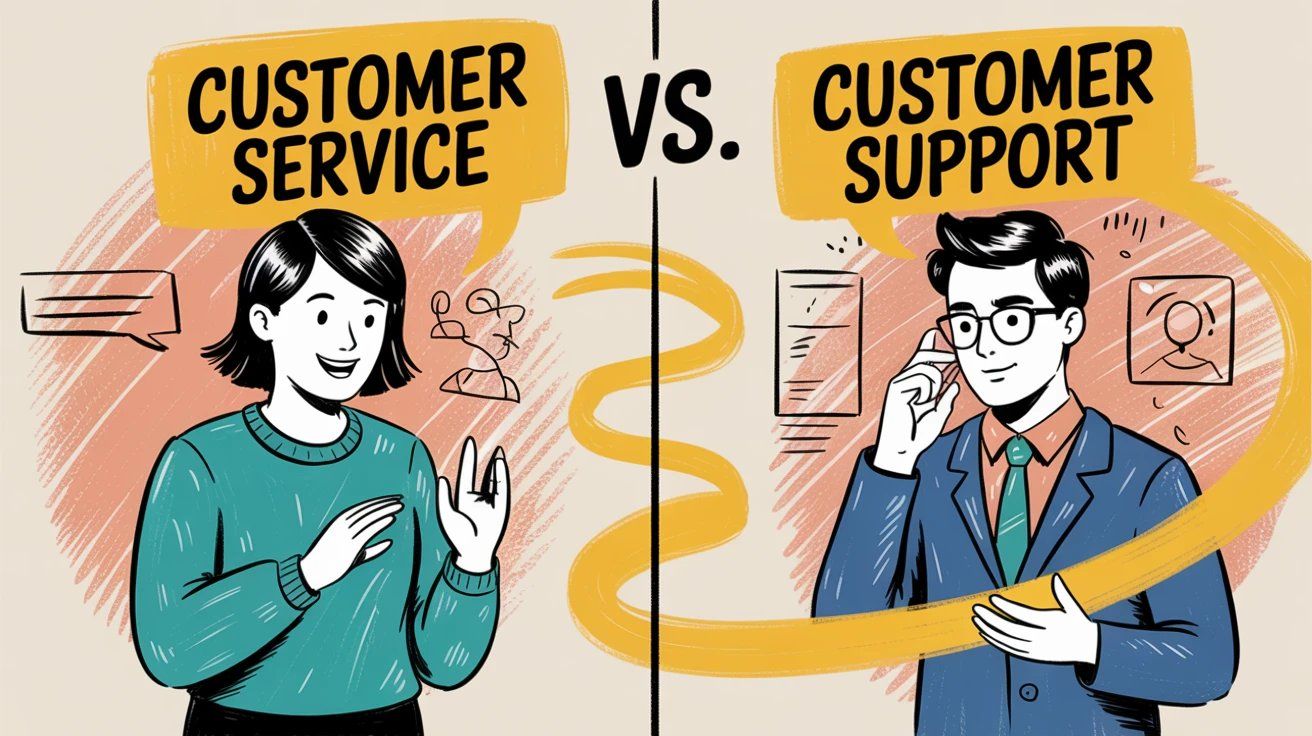
Customer Service vs Customer Support - Explained (2025)
Discuss with AI
Get instant insights and ask questions about this topic with AI assistants.
💡 Pro tip: All options include context about this blog post. Feel free to modify the prompt to ask more specific questions!
TL;DR: Customer service builds relationships across your entire customer journey, while customer support solves specific technical problems. You need both to create exceptional experiences, and modern platforms like Spur can unify them with actionable AI that handles repetitive queries while routing complex issues to your team.
Your customer-facing team is probably drowning right now. Instagram DMs piling up, WhatsApp messages going unanswered, live chat requests multiplying faster than you can respond. Some customers need help choosing a product. Others can't log into their account. A few are reporting bugs. And you're trying to handle all of it with the same approach, the same people, the same confused strategy.
Part of the problem? Most businesses treat "customer service" and "customer support" as interchangeable terms. They're not. Understanding the distinction isn't just semantics. It impacts how you structure teams, train staff, measure success, and deliver experiences that actually keep customers coming back.

Customer service is the umbrella term for everything your business does to help customers before, during, and after a purchase. Industry research shows it's the catch-all for creating smooth, positive experiences throughout the entire customer journey.
Think of it as the human side of your business. When a hotel concierge helps you check in smoothly and recommends a great local restaurant, that's customer service. When an e-commerce rep helps a shopper find the right product size, explains your return policy, or follows up after purchase to ensure satisfaction, that's customer service too.
The goal? Long-term relationship building. Research confirms that customer service focuses on partnership over time, not just solving the immediate transaction.
Who handles it? Customer service reps are typically generalists who know a bit about all your offerings and policies. Their superpower is soft skills: empathy, communication, patience, and the ability to keep interactions positive even when customers are frustrated.
Customer service shows up in virtually every industry. Retail, hospitality, finance, healthcare, you name it. If you have customers, you have customer service in some form. And it's often proactive: great service means anticipating needs before they become problems. A rep might follow up after a sale, offer help while someone's browsing, or check in to ensure everything's going smoothly.

Customer support is much more specific. It's a focused function within customer service, dedicated to helping customers resolve product-related or technical issues. Research describes it as one specific part under the customer service umbrella, concentrating on fixing problems and ensuring customers can use your product successfully.
Take the hotel example again: if that same guest can't connect to the Wi-Fi because the login page won't load, helping them troubleshoot is customer support. When a software user hits an error message, can't complete checkout, or encounters a bug, the team that fixes those issues is providing support.
The focus? Immediate issue resolution. Getting customers unstuck and back to using your product as quickly as possible.
Who handles it? Support agents are product experts with deeper technical knowledge. Industry analysis shows they're skilled in troubleshooting, often work closely with product or engineering teams to report bugs, and need both empathy and hard technical skills. They understand error codes, can read system logs, and know how to diagnose why something isn't working.
Customer support is mostly reactive. Industry research confirms it kicks in when something goes wrong, when a customer reports an issue or asks for help with a problem they've already encountered.
Not every company has a dedicated support department. It's most common in tech, SaaS, e-commerce, and industries where products can break or have complex features. A small bakery probably doesn't need a support team, but a software company absolutely does.
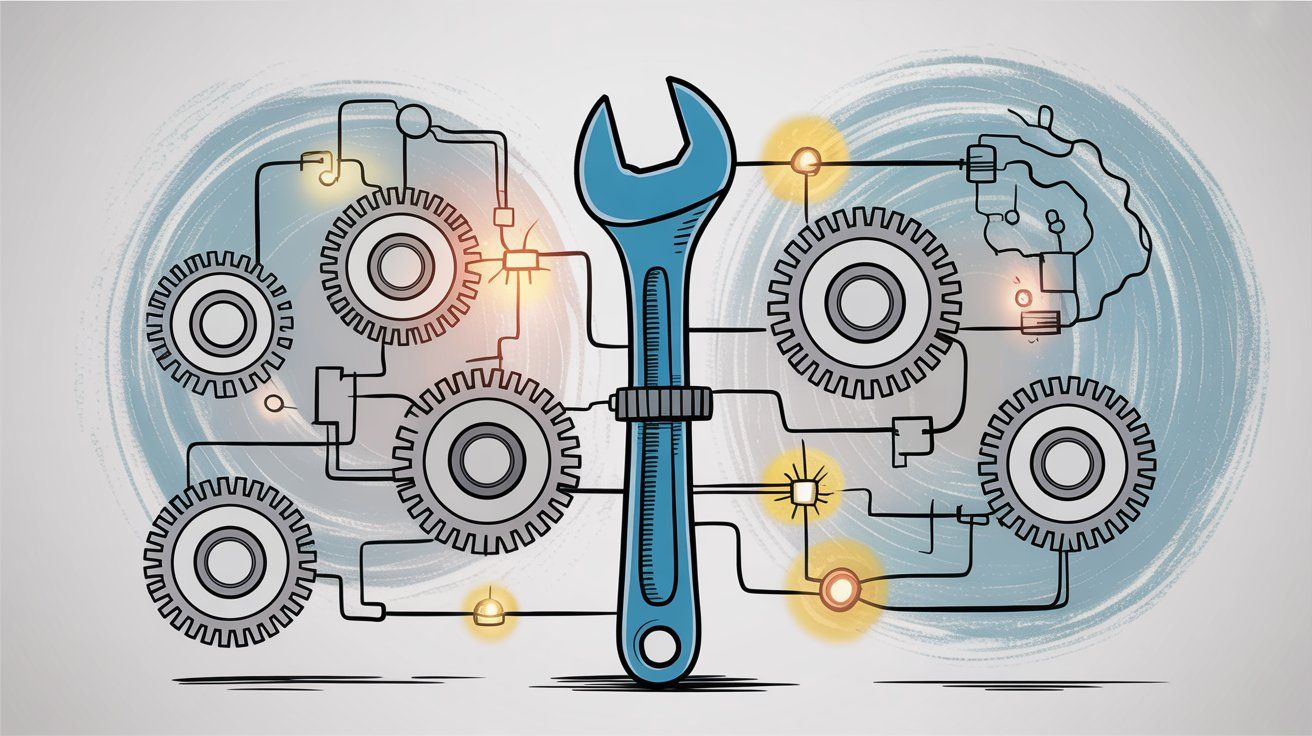
Easy to see why businesses mix these up. They share significant common ground:
Same end goal:
Both roles aim to ensure customers have a positive experience with your company. Whether answering a general question or debugging a product issue, you want the customer happy and satisfied.
Same channels:
Service and support typically interact via the same tools: phone, email, live chat, social media, help desks. Modern customers expect help in real time on their preferred channel, and both teams need to be there.
Overlapping skills:
Empathy, patience, and clear communication are critical for both. Both roles require a customer-centric mindset and strong problem-solving abilities.
Same impact:
Done well, both improve satisfaction and loyalty. Done poorly, either can lead to frustration and churn. Companies that excel at both tend to have a competitive advantage.
In short, service and support are two sides of the same coin. One side focused on the bigger picture of customer relationships. The other on specific solutions to problems.
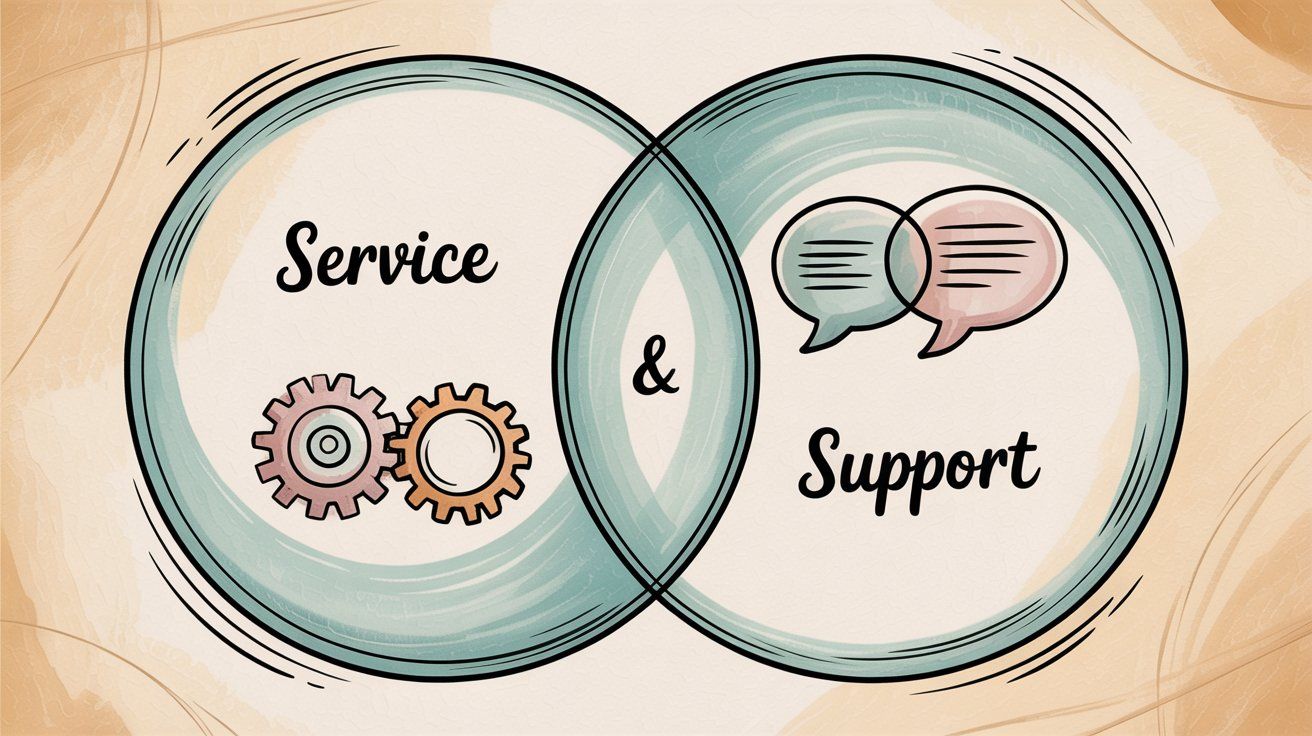
While they share similarities, there are clear distinctions in scope, approach, and objectives:
| Difference | Customer Service | Customer Support |
|---|---|---|
| Scope | Broad, relationship-focused covering all interactions | Narrow, problem-focused on product/technical issues |
| Approach | Often proactive (anticipating needs) | Typically reactive (responding to problems) |
| Journey Stage | Entire journey (pre-sale, during, post-sale) | Mostly post-purchase when using product |
| Issue Types | General inquiries, standard requests, policy questions | Specific technical problems, troubleshooting, bugs |
| Skills Required | Soft skills, broad knowledge, empathy | Technical expertise, product knowledge, plus soft skills |
| Metrics | CSAT, NPS, retention, loyalty | Resolution time, first-response time, ticket volume |
| Industry Presence | Universal (every customer-facing business) | Common in tech, SaaS, complex products |
Breaking down the most important distinctions:
Customer service is an umbrella encompassing all interactions that enhance customer experience and relationships. Customer support is one specific piece under that umbrella. Research explains: service is about the "why" (long-term customer happiness), support is about the "how" (solving the problem right now).
Service interactions cover anything from product advice to billing questions. Support interactions zero in on making sure the product works.
Service teams try to anticipate needs and address issues before they become problems. Offering help while a customer browses, checking in after purchase, suggesting related products. Industry research shows customer service is usually proactive.
Support typically steps in when something goes wrong. Error messages, outages, user difficulties that have already occurred. It's reactive by nature.
While both need people skills, the requirements differ significantly. Service reps are generalists who excel at staying calm, friendly, and helpful. They draw on broad knowledge of products and policies.
Support reps need those same people skills, but layered with strong technical skills. According to industry research, they must be adept at using tools, understanding error codes, and diagnosing complex issues.
You might hire a service rep for hospitality talents and train them on products. You'd hire a support rep for troubleshooting prowess and then coach customer empathy.
Service teams often measure success through customer satisfaction scores (CSAT), Net Promoter Score (NPS), and retention rates. The goal is happy customers who return and recommend your business.
Support teams care about those same satisfaction metrics, but also closely track operational efficiency: resolution time, first-response time, ticket closure rates. A "win" might be resolving 90% of technical inquiries within 24 hours.
Both contribute to loyalty, but they approach it from different angles. Service enhances the overall relationship. Support minimizes product friction.
This isn't just vocabulary. The distinction has real operational impact:
When a customer reaches out, knowing whether they need "service" or "support" gets them the right help faster. Someone with a billing question needs customer service. Someone with a software glitch needs customer support. Companies that route issues correctly resolve things more efficiently and keep customers happier.
Misdirected requests frustrate everyone. A support tech trying to upsell, or a service rep struggling with a technical question, neither helps anyone.
Many businesses split these functions into different teams or roles. Customer service might sit under customer experience or sales departments. Customer support often aligns with product or engineering teams.
Recognizing the different skill sets and career paths is crucial for hiring and training. Service roles might emphasize hospitality training and conflict resolution. Support roles might require product certification or technical education.
Career growth differs too. Service roles could lead to account management or customer success. Support roles might progress into technical support engineering or product management.
Service and support are measured on different KPIs. Leaders need to set goals appropriate to each function. You wouldn't judge a support engineer by sales influenced, nor a service rep by bugs fixed.
By differentiating the roles, companies can analyze where to improve: maybe your service is great (high CSAT) but support is lagging (slow resolution), or vice versa. Then you know where to invest.
When companies get both right, they deliver a complete experience. Customer service keeps the relationship strong. Customer support keeps the product running smoothly. When you get both right? That's when customers stick around.
If either side falls short, the overall experience suffers. Even brilliant technical support can't compensate for rude service. And friendly service can't overcome persistent product issues.
Rather than thinking "either/or," successful businesses see service and support as complementary. In practice, there's often handoff between the two. A service rep escalates a technical question to support. Support agents spot confusing features and feed that back to service for proactive communication.
The challenge? Managing this across multiple channels (WhatsApp, Instagram, Facebook, live chat) without dropping balls or losing context.
This is where modern platforms like Spur change the game.
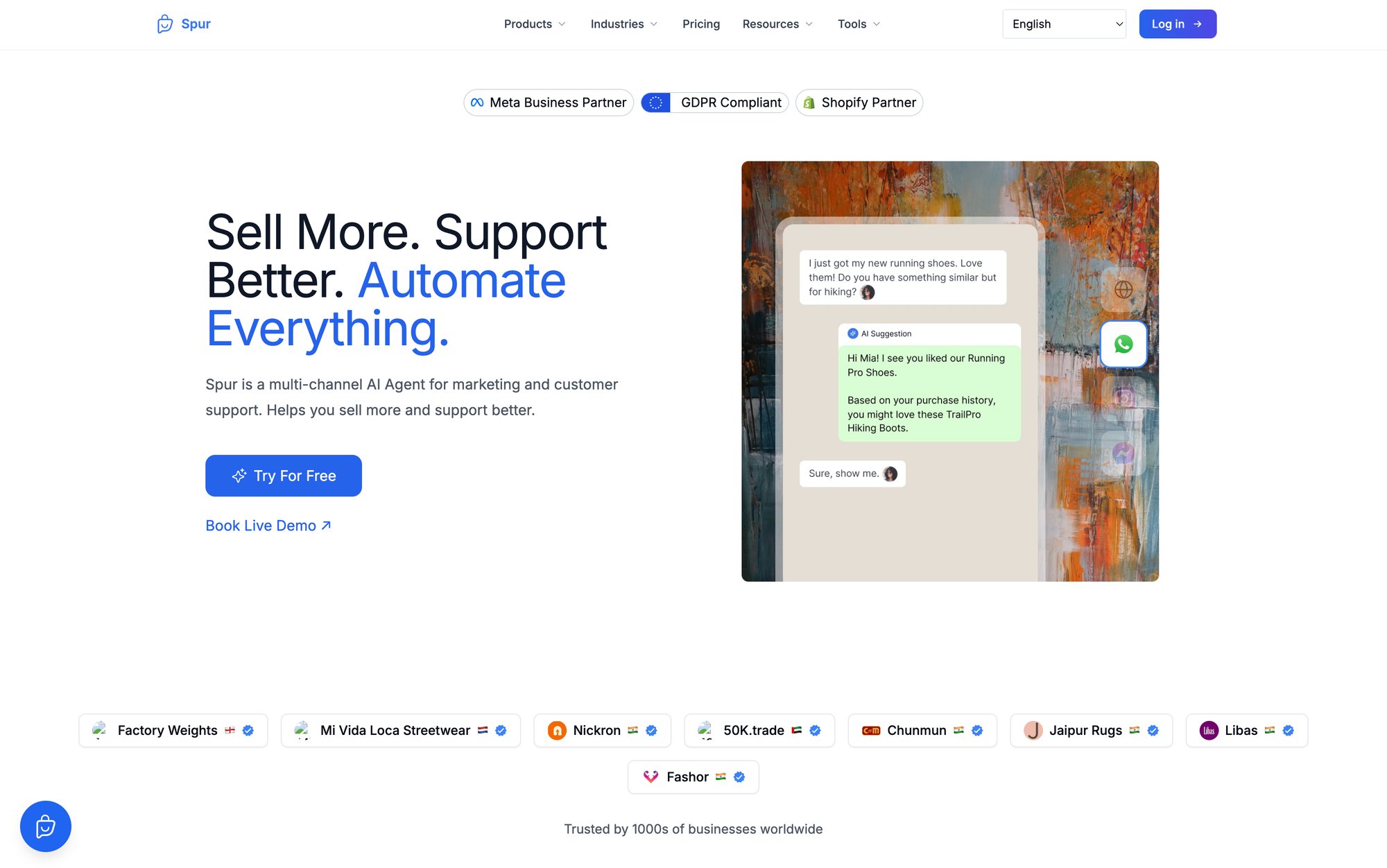
Instead of juggling separate tools for different channels and functions, Spur unifies everything in a shared inbox with intelligent routing. Your team sees WhatsApp messages, Instagram DMs, Facebook inquiries, and live chat requests in one place. Context stays connected whether a customer is asking a sales question or reporting a bug.
But what makes this actually work:
Most chatbots are glorified FAQs. They answer "Where's my order?" but can't actually do anything about it.
Spur's AI agents are different. They can take actions: track orders, update records, book meetings, check inventory. Train them on your knowledge base and they handle the repetitive service queries (product questions, policy info, simple troubleshooting) while routing complex support issues to humans through seamless handoff.
According to recent analysis, companies using AI-driven support saw up to 30% lower support costs and faster response times without sacrificing quality.
This is how it works in practice:
For customer service:
• Spur's Instagram automation handles comment-to-DM flows, story reactions, and lead qualification
• WhatsApp Business API powers broadcasts, drip campaigns, and cart recovery
• Live chat widget captures website visitors and collects lead information
For customer support:
• AI agents troubleshoot common technical issues instantly using chatbot best practices
• Complex problems route to the right team member with full context through help desk systems
• Knowledge base training means accurate, consistent answers
• Automation handles password resets, account lookups, order tracking
The key is the seamless handover. Effective automation focuses on what machines do best (speed, consistency, 24/7 availability) while empowering humans to build relationships and solve challenging problems.
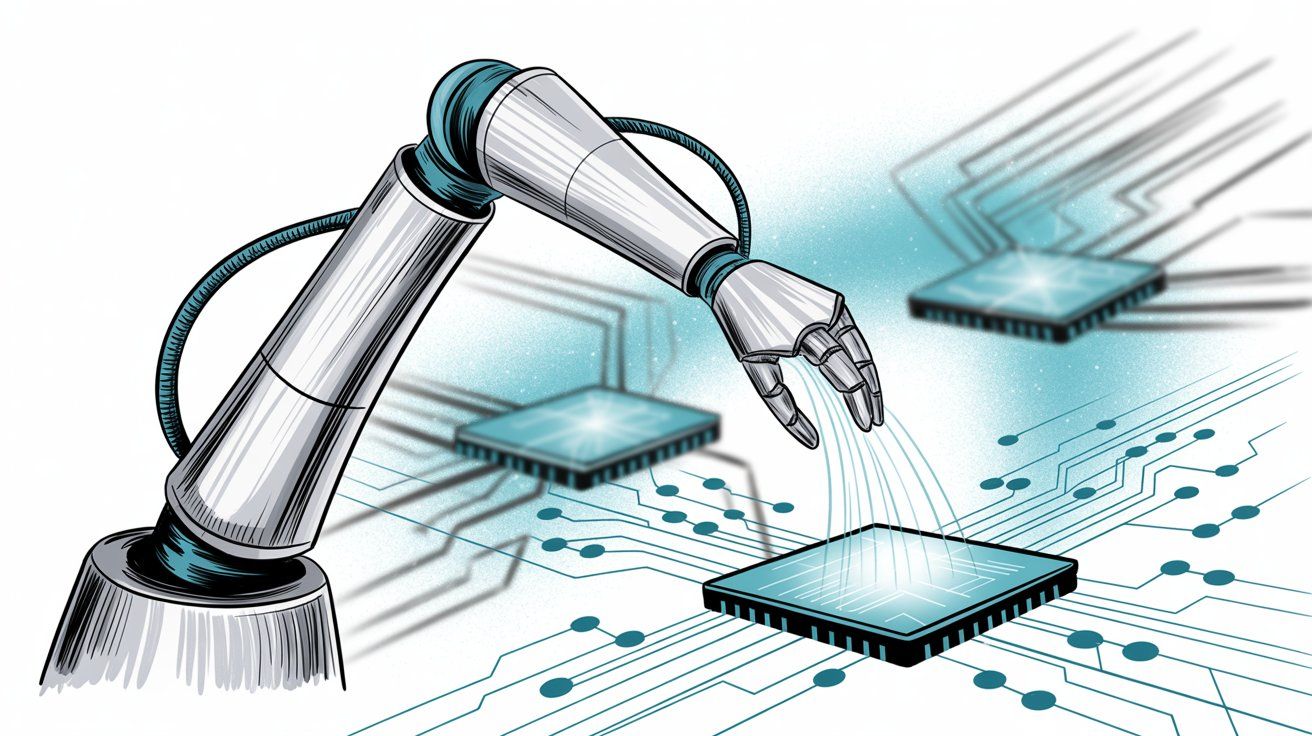
Your customers don't think in terms of departments. They just want their needs met and their problems solved, wherever they reach out.
Spur delivers that unified experience across channels. A customer can start a conversation on Instagram, continue it on WhatsApp, and get consistent, contextual help throughout. Whether it's a pre-sale question (service) or a technical issue (support), the platform routes it correctly and maintains continuity.
For teams managing both service and support, this eliminates the chaos of switching between tools, losing conversation history, and manually routing requests. Everything flows through one intelligent system.
The trend for 2025 and beyond is integration. Job titles like "Customer Success Manager" increasingly blur the line between proactive service and reactive support. Customers don't care about your organizational chart. They want their needs met.
The best companies foster tight collaboration between service and support teams, sharing customer feedback in real time. When these teams work together, they create a complete picture of customer needs and pain points.
Technology makes this easier. Unified platforms mean service reps can see support ticket history. Support agents can access sales context. Everyone works from the same data, the same goals, the same mission: exceptional customer experience.
Yes, especially in smaller businesses. The skills overlap enough that trained generalists can handle both. But as you scale, specialization makes sense. Service people focus on relationships and broader questions. Support people dive deep into technical problem-solving. Both roles are valuable, just different.
Ask yourself: Do customers frequently encounter technical issues that require troubleshooting? Are you in tech, SaaS, or selling complex products? If yes, dedicated support makes sense. If your product "just works" and most questions are about purchases, policies, and general help, a unified service team might be enough.
Both typically use the same channels (email, chat, phone, social media). The difference isn't the channel, it's the expertise and type of help provided. Modern platforms like Spur let you route different inquiry types to the right people across all channels.
AI chatbots can handle both. For service: answering FAQs, qualifying leads, providing product information, processing simple requests. For support: troubleshooting common issues, resetting passwords, checking order status, walking through basic fixes. The key is using actionable AI that can actually solve problems, not just answer questions.
Yes and no. Both should track customer satisfaction (CSAT, NPS). But service might also measure retention rates, upsell success, and relationship quality through performance indicators. Support should add resolution time, ticket volume, first-contact resolution rate, and escalation frequency. Shared metrics align teams; specific metrics reflect different objectives.
Start by analyzing your incoming requests. What percentage are general questions vs. technical issues? If 30%+ are technical, consider creating a support function. Train your most technical-minded service reps first. Implement routing based on inquiry type. Use tools that make handoffs seamless so nothing falls through cracks.
Treating them as identical when they're not. Expecting service generalists to solve complex technical problems burns them out and frustrates customers. Conversely, having highly technical support staff handle simple billing questions wastes expensive expertise. Get the routing right and everyone's happier.
Absolutely. Many companies outsource basic service (FAQs, general inquiries, order status) to cost-effective teams or AI automation, while keeping product support in-house with engineers who deeply understand the product. Tools like Spur make this easier by handling tier-one queries automatically, escalating only what truly needs human expertise.
Automation has blurred some lines. AI can now handle many routine support tasks that previously required technical humans. This frees support staff for truly complex issues. Meanwhile, automated service (like cart recovery on WhatsApp or Instagram lead qualification) lets service teams focus on high-value relationship building. The result? Both functions become more strategic, less transactional.
Look for platforms that offer: (1) multi-channel unified inbox, (2) intelligent routing based on inquiry type, (3) AI that can take actions (not just answer), (4) knowledge base integration, (5) seamless handoff between automated and human help. Spur checks all those boxes, especially for businesses using WhatsApp, Instagram, Facebook, and live chat.
Customer service is the wide-angle lens covering all interactions aimed at satisfaction and loyalty, from pre-sale advice to post-sale care. Customer support is the zoom lens dealing with specific technical or product issues to ensure successful usage.
You need both.
A company with fantastic service but no support leaves customers stranded when things break. A company with brilliant support but poor service may fix issues but fail to win hearts. The combination creates exceptional experiences.
As one industry analysis puts it: customer service keeps the relationship strong. Customer support keeps the product running smoothly. When you get both right? That's when customers stick around.
Understanding the difference helps you staff teams correctly, train the right skills, set appropriate KPIs, and meet customers where they are with the help they actually need.
Modern platforms like Spur make this easier by unifying both functions with actionable AI that handles repetitive work and intelligently routes complex issues to humans. Whether you're managing WhatsApp broadcasts, Instagram engagement, or live chat support, having everything in one place with smart automation transforms both service and support from cost centers into competitive advantages.

Ready to unify your customer service and support? Explore how Spur can help.
